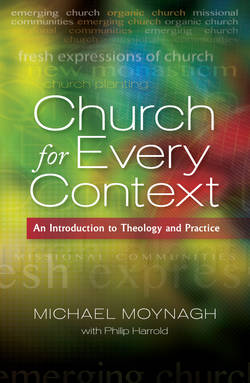Читать книгу Church for Every Context - Michael Moynagh - Страница 85
На сайте Литреса книга снята с продажи.
Conclusion
ОглавлениеNew contextual churches are emerging in Britain through processes of disequilibrium, amplification, self-organization and stabilization. Already they are having a substantial influence on ecclesial life, not only in this country but in other parts of the world. Do they represent the early stages in the birth of a new attractor, the mixed-economy church?
There are positive signs. The idea of fresh expressions, even if the term is not used, is taking root in denominations beyond those officially involved in the Fresh Expressions initiative – from the Assemblies of God to the Baptist Church – and overseas (for example Robinson and Brighton, 2009). Denominations associated with Fresh Expressions have steadily deepened their commitment. By 2009 19 out of 43 Church of England dioceses reported that they had created a strategy for encouraging fresh expressions of church and church planting (A Mixed Economy for Mission, 3.2).
A telling sign is how church organizations and networks are responding increasingly to the fresh expressions agenda, whether it is publishers, mission agencies or missional networks. Cell UK, for example, is now working in the spirit of ‘4 life’ to underline its focus on encouraging missional communities in the context of everyday life.
The number of fresh expressions continues to multiply. In 2010, the Methodist Church counted 941 fresh expressions, associated with 723 churches out of a total of 5,162 – 14 per cent (Are We Yet Alive? 2011, p. 14). In 2011, the Church of England identified at least 1,000 parishes – 6 per cent of the total – with a fresh expression of church.15 In both cases the definition was wider than the ‘new contextual church’ one used here. Even so, the relatively rapid spread of the language suggests that, at the very least, the concept of fresh expressions is helping the inherited church to think in more missional terms.
An informed estimate reckons that 50 to 100 churches had or were starting mid-sized communities by 2011, with the number of such churches growing rapidly. If each church had five communities, a not unreasonable assumption, 250 to 500 mid-sized communities – serving people outside the church – would be involved.16 Many of these may not have been counted as fresh expressions in the Methodist and Church of England surveys.
Despite this progress, a 2009 report to the Church of England’s General Synod could identify only three dioceses (out of 43) whose strategies for fresh expressions really stood out. ‘Even in these dioceses there is still a long way to go before it could be said that a mixed economy church has been established as irreversible and normative . . .’ The majority of lay people were unaware or had only a very partial understanding of the mixed economy (A Mixed Economy for Mission 2009, 4.9, 4.28).
Anecdotal evidence and some limited research (for example, Stone, 2010) suggest that most fresh expressions are small, have a significant proportion of people who already go to church, and where they are reaching out are connecting with people on the fringe of church rather than the growing numbers of never-churched. There are encouraging exceptions, but the overall picture is of the UK church being still at the beginnings of a journey to fresh expressions. Despite growing momentum, the vehicle could yet stall.
